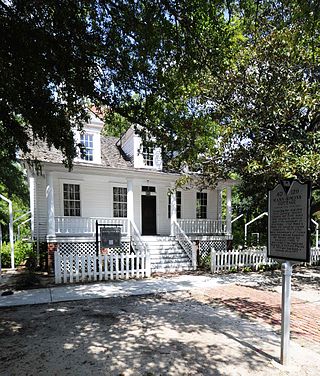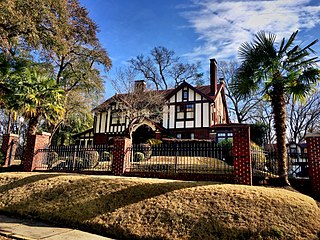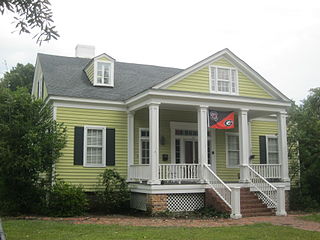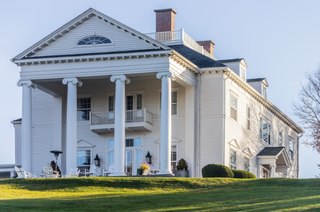
The South Carolina School for the Deaf and the Blind is a school in unincorporated Spartanburg County, South Carolina, United States, near Spartanburg and with a Spartanburg postal address. It was founded in 1849 by the Reverend Newton Pinckney Walker as a private school for students who were deaf. The School for the Blind was established in 1855, and the school became state funded in 1856.

Perry-McIlwain-McDow House, also known as Fairview Farm, is a historic home located near Lancaster, Lancaster County, South Carolina. It was built about 1840, and is a 1+1⁄2-story, Greek Revival raised cottage. It has a temple-front classical portico containing a recessed porch with balustrade.

The Zimmerman House is a historic home located at Columbia, South Carolina, United States. It was built in 1848, and consists of a 1+1⁄2-story main section and a one-story wing. The front façade features a Greek Revival style pedimented portico supported by two paneled wooden square columns. The house was built by Charles and Hannah Zimmerman, who operated the neighboring Zimmerman School from 1848 to 1870.

Horry-Guignard House is a historic home located at Columbia, South Carolina. It was built before 1813, and is a two-story, late Federal style, modified I-house type frame dwelling. The front facade features a one-story, full-width balustraded porch supported by square columns. During the winter of 1813–1814, the main hall was widened from six feet to eleven feet. To do this, the house was sawed in half and the two ends were pulled apart to rest on two new foundations. It was probably built by Peter Horry (1747-1815), a Revolutionary War Colonel and Brigadier General of the South Carolina Militia. Later, the house was acquired by John Gabriel Guignard (1751-1822), the Surveyor General of South Carolina from 1798 to 1802. Guignard is responsible for the early design of the city and laid out the first streets of Columbia.

Preston C. Lorick House, also known as the Lorick-Baker House, is a historic home located at Columbia, South Carolina. It was built before 1840, and remodeled in the late 1800s in the Late Victorian style. It is a two-story, frame dwelling, with a wraparound portico. The house features decorative brackets under all eaves and gingerbread woodwork. It was the home of Governor John Lawrence Manning during his term of office from 1852 to 1854.

Debruhl-Marshall House is a historic home located in Columbia, South Carolina. It was built in 1820, and is a two-story, five bay, brick Greek Revival style dwelling. It has a gabled slate roof and full basement. The front facade features a three bay portico supported by four massive Doric order columns.

Mann-Simons Cottage is a historic home located at Columbia, South Carolina. It was built around 1850, and is a 1+1⁄2-story, cottage style frame house on a raised basement. The front façade features a porch supported by four Tuscan order columns. It was the antebellum home of a substantial free black Columbia family.

McCord House, also known as the McCord-Oxner House, is a historic home located at Columbia, South Carolina. It was built in 1849, and is a 1½-story clapboard Greek Revival style cottage, with additions made in the 1850s. It sits on a stuccoed raised basement. The front facade features a one-story portico supported by four stuccoed piers. It was built by David James McCord (1797–1855), a planter, lawyer, and editor, and his wife Louisa Susannah Cheves McCord, a noted author of political and economic essays, poetry, and drama. In 1865, the McCord House became the headquarters of General Oliver O. Howard, who was General William Tecumseh Sherman’s second in command. It was added to the National Register of Historic Places in 1979. The house is currently owned by Henry McMaster, the incumbent Governor of South Carolina, who purchased the property in May 2016.

Dovilliers-Manning-Magoffin House, also known as the McKay House, is a historic home located at Columbia, South Carolina. It was built in 1856, and is a 1+1⁄2-story clapboard Greek Revival style cottage. It sits on a raised basement. The front facade features a one-story portico supported by four piers. It was the home of Eugene Dovilliers, an artist; the Manning family; and Dr. Ralph Deman Magoffin, a noted classical archaeologist. The house was moved to its present site in 1964.

Ensor-Keenan House is a historic home located at Columbia, South Carolina. It built about 1870, and is a 1+1⁄2-story, Italianate style frame dwelling. It features a central projecting pavilion with a steeply pitched hipped roof and full width front porch. It was the home of Dr. Joshua Fulton Ensor, second medical superintendent of the State Asylum.

W. B. Smith Whaley House, also known as the Dunbar Funeral Home, is a historic home located at Columbia, South Carolina. It built in 1892–1893, and is a three-story, irregular plan, Queen Anne style frame dwelling. It features a corner turret with conical roof and a long curving enclosed front porch. It was built by W. B. Smith Whaley, president of the Columbia Electric Street Railway and Mill Stable Company. In 1924, it became the Dunbar Funeral Home.

Lyles-Gudmundson House is a historic landmark home located in Columbia, South Carolina. It was built between 1918 and 1922, and is a two-story Classical Revival style brick dwelling. The home was a wedding gift for Evelyn Robertson Lyles, the daughter of Edwin Wales Robertson. A banker who is credited with much of Columbia's early twentieth century development, Robertson commissioned New York City architect James Brite to design his daughter's home as part of his Wales Garden neighborhood. Brite - a native North Carolinian who died in 1942 - was also the architect of The Braes in Glen Cove, New York and the famous Darlington Mansion near Mahwah, New Jersey.

Taylor House, also known as the former home of the Columbia Museum of Art, is a historic home located at Columbia, South Carolina. It was designed by the architectural firm of Andrews, Jaques & Rantoul and built in 1908, as a two-story, "L"-shaped, brick Neo-Classical style mansion. The front facade features a projecting portico supported by large, fluted limestone Corinthian order columns. It was built for Thomas Taylor, Jr., who served as president of Taylor Manufacturing Company.
Laurelwood is a historic plantation house located in rural Richland County, South Carolina, near the city of Eastover. It was built about 1830, and is a two-story frame dwelling with a central-hall, double-pile plan. The front façade features a two-tier, three bay, pedimented portico in the Greek Revival style. It has a one-story, frame addition built in the early-20th century. Also on the property are the contributing frame smokehouse and a frame barn. Also notable is the survival of a slave quarters.

A. Fletcher Spigner House, also known as the Spigner-Wilson-Seibels House and Hanner House, is a historic home located at Columbia, South Carolina. It was built in 1920, and is a 2+1⁄2-story double-pile, rectangular frame residence in the Tudor Revival style. It has a one-story, central front portico, a red terra cotta tile roof, and faux half-timbering with a finish of stucco on the second floor. Also on the property is a 1+1⁄2-story garage. It was built for A. Fletcher Spigner, a prominent Columbia attorney, State Senator, and South Carolina's Fifth Circuit Solicitor.

Elizabeth White House is a historic home in Sumter, Sumter County, South Carolina. It was built about 1854, and is a 1 1/2-story vernacular Greek Revival cottage. The front facade features a pedimented one-story portico supported by four square columns. It was the home of artist Elizabeth White (1883-1976). Under the provisions of White's will, the property was transferred to the Sumter Gallery of Art for use as an art gallery.

Hart House is a historic home located at York, York County, South Carolina. It was built about 1855, and is a frame Greek Revival style raised cottage on a brick foundation. It features Palladian windows in the gable ends and a double portico with simple square columns.

Witherspoon-Hunter House is a historic home located at York, York County, South Carolina. It was built about 1825, and consists of a two-story, front section covered by a gable roof, with a one-story L-shaped rear annex. The house is of frame construction and rests upon a raised brick basement. It features a double-tiered front portico. Also on the property is a small brick building.

Stokes-Mayfield House is a historic home located at Rock Hill, South Carolina. It was built in 1907, and is a two-story, frame residence with cross-gabled slate roof in the Neo-Classical style. The house features a two-story tetrastyle Corinthian order pedimented portico and a balcony with decorative iron brackets above the front door.

Westglow, also known as the Elliott Daingerfield House, is a historic home located near Blowing Rock, Watauga County, North Carolina. It was built in 1917, and is a 2+1⁄2-story, rectangular, Colonial Revival style frame dwelling with a hipped roof. It has a two-story hip roof extension. The front facade features a monumental tetrastyle portico supported by columns with Ionic order capitals. Also on the property are the contributing artists studio and caretaker's cottage (1920s). It was the summer home and studio of artist Elliot Daingerfield (1859-1932).























